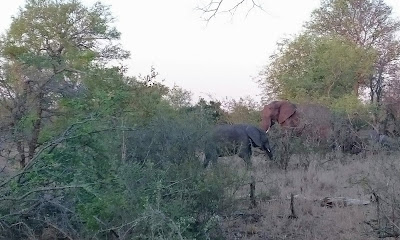Elephant Sighting Data Collection
When we come across elephants during our game drives, we collect specific data about these sightings. Typically, elephants travel in herds which are comprised of adult females (cow) and male and female sub adults, immatures, juveniles, and infants (calf.) Adult males (bull) may be with the herd also, but they roam freely as well. For that reason, it is also possible to have sightings of small groups of bulls or a bull all alone.
I wasn't even shown this sheet until my second week here. Would have been useful to see it earlier than that. (This seems to be a trend here.)
When we see a herd, it is my job to try to count how many cows, calves, and bulls there are. This may sound easy enough, but it is extremely difficult. Usually the herds are feeding on leaves, so the elephants are interspersed among bushes and trees which block my view. Also, elephants block my view of other smaller elephants. As long as the herd does not seem to be getting aggressive or bothered, we stay and watch them for at least 10 to 20 minutes. This gives me more of a chance to count the elephants correctly as they move along.
Time to get the data sheet out and try to count the elephants.
Elephants feeding. It's so cute!
A bull by himself bathing and drinking. Also super cute!
Elephant ID Kits
Did you know that you can distinguish one elephant from another by looking at their ears and tusks? I knew that elephant tusks came in different sizes, but I had not realized that elephant ears were so distinct. If you get a good-enough look, you will begin to notice that most elephant ears have notches, holes, and/or ripples to them.
Female elephants have high bumps on their foreheads.
Male elephants have smoother, rounded foreheads.
Trunk and leg size and features about the tail are also things that can help distinguish different elephants.
My Mexican roommate and I had the task of reviewing the existing pages in the elephant ID Kit booklet. We were shocked at how much information in this booklet was incorrect. Features of a right ear were mistakenly listed as being for the left ear. Or photos of two different elephants were being used as if they were the same elephant. We decided that we needed to go over each page and double-check (but in most cases actually re-write descriptions and remove certain photos) to be sure that the ID Kit contained accurate information.
Nice try previous volunteers, but we'll take it from here. (My edits are the writing in pencil.)
We decided that there were so many errors that the ID Kit pages all needed to be re-written and re-printed. A new template was also created for the information to be written in. We added some "new" elephants to the ID Kit as well. I am glad that we were able to accomplish a lot in improving the elephant ID Kits. I also made the suggestion that all new volunteers should be given a practice quiz for describing the features of a bull and cow so that the staff will know if the volunteers understand how to describe and identify elephants correctly.
The new description chart template.
In the ID Kit, the adult elephants are labeled by their gender, followed by a number. The females are also identified by their herd, which are given different numbers. Sometimes though, the elephants are also identified by a name which could have come from either an outside source or this project itself. To be useful, the names should be descriptive, such as naming an elephant "One Tusk" if one of their tusks is missing.
A bull missing a tusk.
One of the bulls that was already included in the kit had a huge, distinctive hole in his ear, but he was not given a name. The staff member overseeing this project said that she had been trying to think of the perfect name for this elephant, but could not come up with one. I suggested the name "Teardrop" since I felt the hole was in the shape of a teardrop, and she loved it! So, this elephant shall now be known at this research program as "Teardrop."
I hoped that I would get to see Teardrop in person during one of our elephant sightings, but I never did. I will carefully look through all of my photos again though just to be sure. If you ever come to South Africa, keep an eye out for my elephant!















No comments:
Post a Comment